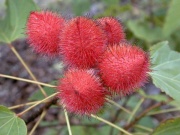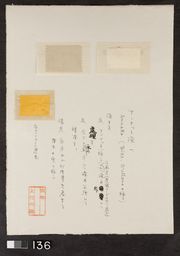Difference between revisions of "Annatto"
(username removed) |
|||
| (8 intermediate revisions by 4 users not shown) | |||
| Line 2: | Line 2: | ||
== Description == | == Description == | ||
| − | A natural orange [ | + | A natural orange [[dye|dye]] obtained from the lipstick plant which is a small tree, ''Bixa orellana'', native to Central and South America. The seeds from the plant are contained in a pod surrounded with a bright red pulp. Annatto is extracted from the pulp with boiling [[water|water]] then precipitated with a dilute [[acid|acid]] (vinegar or lemon juice). It floats to the top of the solution and is skimmed off and shaped into cakes and wrapped in banana leaves. Annatto contains several [[tannin|tannins]] and flavones, primarily [[bixin|bixin]] and nor-bixin. A bright orange lake is prepared by precipitating annatto on [[alumina%20trihydrate|alumina trihydrate]]. Annatto also colors [[leather|leather]], [[wool|wool]], [[silk|silk]], and [[cotton|cotton]] evenly. However, it is not very lightfast or washfast. Annatto was used in indigenous cultures as a textile and skin dye. From the 16th century, annatto was occasionally used in Europe for color in [[varnish|varnishes]], [[oil|oils]], [[wax|waxes]], and [[stain|stains]]. Currently, annatto is used to color butter, cheese, and cosmetics. |
| + | |||
| + | [[File:Uemura 06-04-2009 136.jpg|thumb|Three samples of annatto dyed silk<br>Uemera Dye Archive]] | ||
== Synonyms and Related Terms == | == Synonyms and Related Terms == | ||
| Line 8: | Line 10: | ||
''Bixa orellana''; Natural Orange 4; CI 75120; achiote (Esp.); bija orellana (Esp.); Annatto (Deut.); annatto (It., Ned.); echter Orlean (Deut.); roucou (Fr.); orlean (Deut., Ned.); achiote (Esp.); terra orellana (Esp.); terra oriana (It.); annotto; anotta; anatto; orange lake; annotta; arnotta; arnoto; achiotl; butter color; onoto; urian; rocoa; roccu; bixin; kesae; lathan; morning red; aurora; racourt; otter; urucu; | ''Bixa orellana''; Natural Orange 4; CI 75120; achiote (Esp.); bija orellana (Esp.); Annatto (Deut.); annatto (It., Ned.); echter Orlean (Deut.); roucou (Fr.); orlean (Deut., Ned.); achiote (Esp.); terra orellana (Esp.); terra oriana (It.); annotto; anotta; anatto; orange lake; annotta; arnotta; arnoto; achiotl; butter color; onoto; urian; rocoa; roccu; bixin; kesae; lathan; morning red; aurora; racourt; otter; urucu; | ||
| − | == | + | == Physical and Chemical Properties == |
Bixin is soluble in hot water, ethanol, chloroform, oil, alkali solutions. | Bixin is soluble in hot water, ethanol, chloroform, oil, alkali solutions. | ||
| − | + | Composition = C27H34O4 | |
| − | |||
| − | |||
| − | |||
| − | |||
| − | == | + | == Resources and Citations == |
| − | J.Hofenk-de Graaf, ''Natural Dyestuffs: Origin, Chemical Constitution, Identification''. Central Research Laboratory for Objects of Art and Science, Amsterdam, September 1969. | + | * J.Hofenk-de Graaf, ''Natural Dyestuffs: Origin, Chemical Constitution, Identification''. Central Research Laboratory for Objects of Art and Science, Amsterdam, September 1969. |
| − | + | * See [[https://cameo.mfa.org/wiki/Category:Uemura_dye_archive '''Uemera Dye Archive''' (Annatto)]] | |
| − | * | + | * E.J.LaBarre, ''Dictionary and Encyclopedia of Paper and Paper-making'', Swets & Zeitlinger, Amsterdam, 1969 |
| − | * ''Encyclopedia Britannica'', http://www.britannica.com Comment: "annatto" | + | * ''Encyclopedia Britannica'', http://www.britannica.com Comment: "annatto" [Accessed October 2, 2001]. |
| − | * | + | * Ralph Mayer, ''A Dictionary of Art Terms and Techniques'', Harper and Row Publishers, New York, 1969 (also 1945 printing) |
| − | * | + | * Matt Roberts, Don Etherington, ''Bookbinding and the Conservation of Books: a Dictionary of Descriptive Terminology'', U.S. Government Printing Office, Washington DC, 1982 |
| − | * | + | * R.J. Adrosko, ''Natural Dyes in the United States'', Smithsonian Institution Press, Washington, DC, 1968 |
| − | * | + | * Helmut Schweppe, Schweppe color collection index and information book |
| − | * | + | * Richard S. Lewis, ''Hawley's Condensed Chemical Dictionary'', Van Nostrand Reinhold, New York, 10th ed., 1993 |
| − | * | + | * Palmy Weigle, ''Ancient Dyes for Modern Weavers'', Watson-Guptill Publications, New York, 1974 |
| − | * | + | * R.D. Harley, ''Artists' Pigments c. 1600-1835'', Butterworth Scientific, London, 1982 |
| − | * | + | * Sue Fuller, ''Rocks and Minerals'', DK Publishing, Inc., New York City, 1995 |
| − | * | + | * John and Margaret Cannon, ''Dye Plants and Dyeing'', Herbert Press, London, 1994 |
* ''The Merck Index'', Martha Windholz (ed.), Merck Research Labs, Rahway NJ, 10th edition, 1983 Comment: entry 713 | * ''The Merck Index'', Martha Windholz (ed.), Merck Research Labs, Rahway NJ, 10th edition, 1983 Comment: entry 713 | ||
| Line 50: | Line 48: | ||
* ''The American Heritage Dictionary'' or ''Encarta'', via Microsoft Bookshelf 98, Microsoft Corp., 1998 | * ''The American Heritage Dictionary'' or ''Encarta'', via Microsoft Bookshelf 98, Microsoft Corp., 1998 | ||
| − | * | + | * Thomas B. Brill, ''Light Its Interaction with Art and Antiquities'', Plenum Press, New York City, 1980 |
| − | |||
| − | |||
| − | * | + | * F. Crace-Calvert, ''Dyeing and Calico Printing'', Palmer & Howe, London, 1876 |
| − | * | + | * J. Thornton, 'The Use of Dyes and Colored Varnishes in Wood Polychromy', ''Painted Wood: History and Conservation'', The Getty Conservation Insitute, Los Angeles, 1998 |
* Colour Index International online at www.colour-index.org | * Colour Index International online at www.colour-index.org | ||
Latest revision as of 13:19, 22 June 2022
Description
A natural orange Dye obtained from the lipstick plant which is a small tree, Bixa orellana, native to Central and South America. The seeds from the plant are contained in a pod surrounded with a bright red pulp. Annatto is extracted from the pulp with boiling Water then precipitated with a dilute Acid (vinegar or lemon juice). It floats to the top of the solution and is skimmed off and shaped into cakes and wrapped in banana leaves. Annatto contains several tannins and flavones, primarily Bixin and nor-bixin. A bright orange lake is prepared by precipitating annatto on Alumina trihydrate. Annatto also colors Leather, Wool, Silk, and Cotton evenly. However, it is not very lightfast or washfast. Annatto was used in indigenous cultures as a textile and skin dye. From the 16th century, annatto was occasionally used in Europe for color in varnishes, oils, waxes, and stains. Currently, annatto is used to color butter, cheese, and cosmetics.
Synonyms and Related Terms
Bixa orellana; Natural Orange 4; CI 75120; achiote (Esp.); bija orellana (Esp.); Annatto (Deut.); annatto (It., Ned.); echter Orlean (Deut.); roucou (Fr.); orlean (Deut., Ned.); achiote (Esp.); terra orellana (Esp.); terra oriana (It.); annotto; anotta; anatto; orange lake; annotta; arnotta; arnoto; achiotl; butter color; onoto; urian; rocoa; roccu; bixin; kesae; lathan; morning red; aurora; racourt; otter; urucu;
Physical and Chemical Properties
Bixin is soluble in hot water, ethanol, chloroform, oil, alkali solutions.
Composition = C27H34O4
Resources and Citations
- J.Hofenk-de Graaf, Natural Dyestuffs: Origin, Chemical Constitution, Identification. Central Research Laboratory for Objects of Art and Science, Amsterdam, September 1969.
- E.J.LaBarre, Dictionary and Encyclopedia of Paper and Paper-making, Swets & Zeitlinger, Amsterdam, 1969
- Encyclopedia Britannica, http://www.britannica.com Comment: "annatto" [Accessed October 2, 2001].
- Ralph Mayer, A Dictionary of Art Terms and Techniques, Harper and Row Publishers, New York, 1969 (also 1945 printing)
- Matt Roberts, Don Etherington, Bookbinding and the Conservation of Books: a Dictionary of Descriptive Terminology, U.S. Government Printing Office, Washington DC, 1982
- R.J. Adrosko, Natural Dyes in the United States, Smithsonian Institution Press, Washington, DC, 1968
- Helmut Schweppe, Schweppe color collection index and information book
- Richard S. Lewis, Hawley's Condensed Chemical Dictionary, Van Nostrand Reinhold, New York, 10th ed., 1993
- Palmy Weigle, Ancient Dyes for Modern Weavers, Watson-Guptill Publications, New York, 1974
- R.D. Harley, Artists' Pigments c. 1600-1835, Butterworth Scientific, London, 1982
- Sue Fuller, Rocks and Minerals, DK Publishing, Inc., New York City, 1995
- John and Margaret Cannon, Dye Plants and Dyeing, Herbert Press, London, 1994
- The Merck Index, Martha Windholz (ed.), Merck Research Labs, Rahway NJ, 10th edition, 1983 Comment: entry 713
- The American Heritage Dictionary or Encarta, via Microsoft Bookshelf 98, Microsoft Corp., 1998
- Thomas B. Brill, Light Its Interaction with Art and Antiquities, Plenum Press, New York City, 1980
- F. Crace-Calvert, Dyeing and Calico Printing, Palmer & Howe, London, 1876
- J. Thornton, 'The Use of Dyes and Colored Varnishes in Wood Polychromy', Painted Wood: History and Conservation, The Getty Conservation Insitute, Los Angeles, 1998
- Colour Index International online at www.colour-index.org
- Art and Architecture Thesaurus Online, http://www.getty.edu/research/tools/vocabulary/aat/, J. Paul Getty Trust, Los Angeles, 2000

